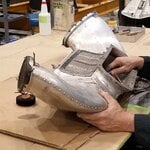MIflyer
1st Lieutenant
Everyone probably is already familiar with the attached observations by Corky Meyer, Grumman WWII test pilot. Also attached is a photo of the right root intake for an F4U, showing how the air has a pretty direct route to the engine intake.
But I wonder about the carb icing problem. I have experienced carb icing only once and it will get you attention. But I wonder how likely you are to have carb icing given that the air is going into a supercharger, which tends to warm things up quite a bit.




But I wonder about the carb icing problem. I have experienced carb icing only once and it will get you attention. But I wonder how likely you are to have carb icing given that the air is going into a supercharger, which tends to warm things up quite a bit.

